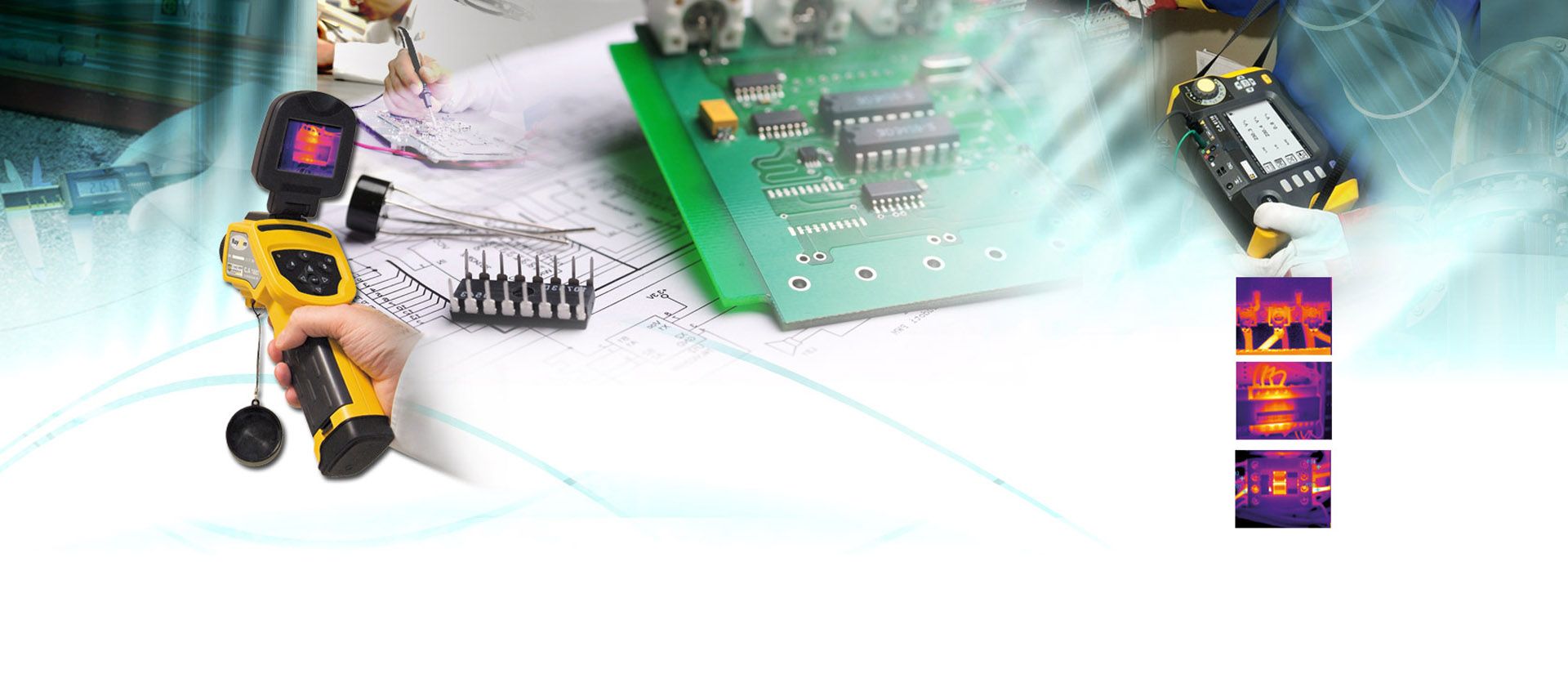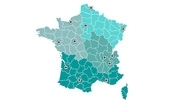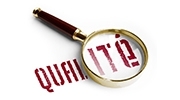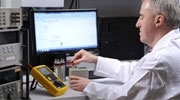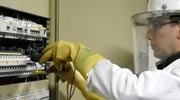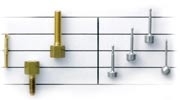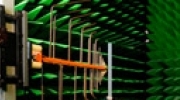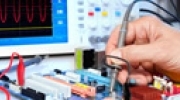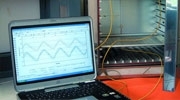Energy efficiency
Energy efficiency: reducing consumption, a major issue! Reducing energy consumption is a crucial goal for companies. Measurement is the only way to achieve it.
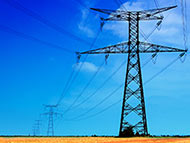 At the heart of companies' and all other organizations' strategies, the improvement of energy efficiency helps to reduce costs and shrink their carbon footprint.
At the heart of companies' and all other organizations' strategies, the improvement of energy efficiency helps to reduce costs and shrink their carbon footprint.
This is a crucial goal in the current economic and environmental context.
Find out more
To help organizations to structure their approach to achieving this objective, standards have been developed to define an energy management system. The ISO 50001 standard recommends, for example, a methodology based on "Plan-Do-Check-Act".
In particular, it defines energy planning and measurement verification phases to draw up a precise diagnosis of the initial situation (identification of energy-hungry areas) and check the effectiveness of the action taken to improve energy efficiency.
Whether the approach is covered by the ISO 50001 system or not, energy efficiency improvement necessarily includes a diagnostic phase involving precise analysis of energy consumption (analysis of the consumption profile and detailed breakdown of consumption).
This helps to identify potential ways of reducing consumption in the major areas, which may lead to modification of the industrial processes, modernization of equipment and machines, building improvement works or changes in personal habits.
Once this action has been taken, checks are performed to ensure that the improvements match the forecasts and, if necessary, to implement corrective action.
Finding out what you consume… Analysis
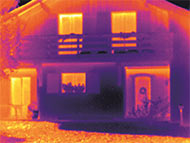 Finding out what you consume is a central part of any energy efficiency initiative.
Finding out what you consume is a central part of any energy efficiency initiative.
By placing power and energy loggers or power analysers on the different electrical feeders downstream from the meter, you can assess the relative weight of each line as part of global consumption, simply and without interrupting the installation's operation, and define a load profile for the installation so that you can determine the priorities regarding orientations for improvements.
Find out more
To complete these initial surveys, a comprehensive range of loggers is available to measure and automatically record the trends over time of voltages, currents, temperatures and process signals.
Analysis of these additional measurements provides essential information for thoroughly understanding the consumption profiles and checking the effectiveness of the modifications made to improve overall energy efficiency.
Point measurements of physical quantities such as temperature, air flow, pressure and lighting can also help you to determine potential ways of improving energy efficiency.
Lastly, thermal cameras are essential tools for drawing up an energy survey of a building. Practical and simple to use, they can detect faults and anomalies such as:
- Thermal bridges
- Poor positioning or absence of insulants
- Infiltration,
- Materials damaged by humidity
- Joints around openings which are no longer leakproof
These are all factors which cause excess consumption.
Analysis of the measurements… Diagnosis
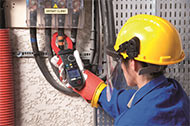 Once all the measurements have been performed and noted, a diagnosis (Enerdis link) is drawn up for the implementation of corrective action.
Once all the measurements have been performed and noted, a diagnosis (Enerdis link) is drawn up for the implementation of corrective action.
A comparison is made between the theoretical efficiency of an installation and the actual measurements.
Several types of corrective action may be taken: resizing of the transformer, implementation of filtering systems, replacement of faulty equipment, etc;
This analysis enables you to provide the best solution in the right place at the right time.
A few examples
A few examples:
- Measurement of the K factor for resizing of the power transformer
http://www.chauvin-arnoux.com/fiches/pdf/fr/Appli_facteur_K.pdf
- Sizing of the capacitor banks for power factor correction
- Reduce you electricity bill!
http://www.chauvin-arnoux.com/fiches/pdf/fr/fiche_appli_mesure_compensation.pdf
For thermal diagnostics on buildings, comparison between the theoretical energy yield and the energy input which it requires helps to determine the improvement work needed.
Depending on the heating, air-condition and ventilation equipment to be set up permanently (e.g. for data centres), the use of thermography before positioning the equipment can help to define an arrangement optimizing both comfort and energy consumption.
Thermal analysis clearly shows hot and cold areas and the thermal exchanges between equipment items.
Checking effectiveness: Testing
 Once the solutions have been implemented, you need to repeat the measurements performed during the audit before correction. Monitoring can then be set up to check that the day-to-day savings achieved persist over time and to avoid the reappearance of drift.
Once the solutions have been implemented, you need to repeat the measurements performed during the audit before correction. Monitoring can then be set up to check that the day-to-day savings achieved persist over time and to avoid the reappearance of drift.
At this stage, it may be decided to define new improvement targets or to take corrective action to achieve or improve on the initial objective.
Measurement is therefore an essential technique on the energy efficiency improvement process.
Measurement of savings
http://pel100.com/fr/le-produit/fonctionnalites/comptage.aspx
Clean energy sources
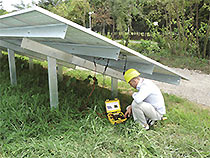 In the context of sustainable development, the share of clean energy has grown significantly in recent years.
In the context of sustainable development, the share of clean energy has grown significantly in recent years.
This includes solar energy. The photovoltaic sector (transforming solar energy into electrical energy), rolled out both in homes and on high-capacity production sites (solar farms) is a major focus for us.
To assess the efficiency of these installations and check solar panels, Chauvin Arnoux proposes solar panel testers specially designed for this application.
Diagnostics & Inspections
Guaranteeing the safety of people and property and identifying potential savings are two important issues for our companies.
In order to guide and focus these objectives, a large number of diagnostics and inspections have been defined, particularly with regard to equipment and installations.
Objectives
Electrical safety of installations
Electrical safety of machines and switchboards
Electrical installation inspections using thermography
Inspection of the work environment
Thermal diagnostics
Energy diagnostics
Objectives
Whether they are performed during commissioning or periodically, the aim of these operations is to establish:
- Compliance with the applicable regulations; such compliance is usually mandatory.
- An assessment of performance according to a standardized procedure; in this case, the threshold values are not necessarily defined.
Diagnostics and inspections are mainly performed by organizations which are independent (of the manufacturer and the customer-user) and possess appropriate authorizations.
Each country defines a set of specific regulations requiring inspections to ensure that they are implemented. In addition, separate voluntary operations are performed to diagnose the performance or safety of a system.
These diagnostics and inspections generally use two types of analysis: visual checks and tests. The tests necessarily involve measurements.
Chauvin Arnoux offers measuring instruments capable of performing these measurements in the following cases:
- Electrical safety of installations
- Electrical, safety of machines and switchboards
- Electrical installation inspections using thermography
- Inspections of the work environment
- Thermal diagnostics
- Energy diagnostics
Electrical safety of installations
 The electrical safety of installations, whether residential, industrial or tertiary, is crucial for guaranteeing the safety of the people present and the premises which they are in. At the end of the construction works, after modifications or periodically (preventive action), these inspections can check:
The electrical safety of installations, whether residential, industrial or tertiary, is crucial for guaranteeing the safety of the people present and the premises which they are in. At the end of the construction works, after modifications or periodically (preventive action), these inspections can check:
- The electrical continuity of the protective equipotential of the mechanical chassis-earths
- The sizing and operation of the protective systems
- The effectiveness of the earthing system
- The quality of the electrical insulants
The IEC 60364 international standard is one of the technical standards defining the rules for the design and construction of a low-voltage electrical installation, as well as the tests for ensuring the finished installation's compliance with the rules.
Bi-function or multi-function installation testers can be used to perform the tests specified in many international and national standards (such as NF C15-100 in France, BS 7671 in the UK, VDE 100 in Germany, etc.).
Electrical safety of machines and switchboards
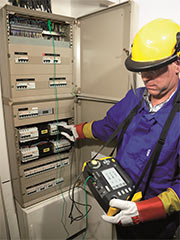 Like electrical installations, electrical machines and switchboards are also subject to regulations designed notably to ensure that they can be used safely. These standards define the type qualification tests (marketing conditions), the commissioning tests (first use) and any periodic testing that needs to be carried out.
Like electrical installations, electrical machines and switchboards are also subject to regulations designed notably to ensure that they can be used safely. These standards define the type qualification tests (marketing conditions), the commissioning tests (first use) and any periodic testing that needs to be carried out.
In particular, the tests specified in the EN60205 and EN61439 European standards can be performed with Chauvin Arnoux Machine Testers.
Electrical installation inspection using thermography
 Alongside the measurements of electrical quantities on installations or machines, it may be useful to carry out a thermographic inspection. For example, in France, the APSAD D19 technical document defines the conditions for thermographic inspections of electrical installations. This thermographic inspection work may be undertaken contractually by the insurer and is in no way a substitute for periodic regulatory testing of electrical installations.
Alongside the measurements of electrical quantities on installations or machines, it may be useful to carry out a thermographic inspection. For example, in France, the APSAD D19 technical document defines the conditions for thermographic inspections of electrical installations. This thermographic inspection work may be undertaken contractually by the insurer and is in no way a substitute for periodic regulatory testing of electrical installations.
The purpose of the inspection is to provide data for decision-making so that suitable corrective and/or preventive action can be taken on installations and equipment, thus avoiding damage to the equipment involved, fires or production shutdowns, for example.
In all cases, the operator performing the task must have obtained the certificate of aptitude for electrical installation inspections using infrared thermography, awarded by the CNPP (French National Prevention and Protection Centre) and must be provided with annually-tested thermographic equipment with sufficient spatial and thermal resolution, such as the C.A 1886 and C.A 1888 cameras.
Inspection of the work environment
Inspection of the work environment: It is up to the employer to assess any hazards facing employees in the context of their work and to take all necessary measures to minimize or eliminate them. For physical hazards, measures whose stringency varies according to the country involved are taken to address air quality, lighting, exposure to noise and exposure to electromagnetic fields.
With regard to lighting, the lighting level must be adapted to the type and precision of the work to be carried out and may vary from 200 lux for office work up to 800 lux for certain difficult laboratory tasks.
For exposure to noise, the maximum levels are defined in European directive 2003/10/CE which was transcribed into French law by decree no. 2006-892 of 19th July 2006. More recently, European directive 2013/35/UE of 26th June 2013 concerning the minimum health and safety specifications concerning workers' exposure to electromagnetic fields needs to be transposed into national law by the member states by July 2016.
Luxmeters, sound level meters, electromagnetic field testers and contact and no-contact thermometers can all be used for these tests.
Thermal diagnostics
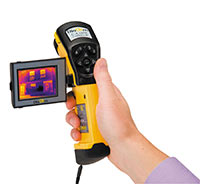 To improve the energy performance of buildings, thermographic cameras are effective tools capable of detecting thermal insulation faults, air infiltration and thermal bridges. Among the numerous applications of thermography (illustrative, for self-testing, after renovation), it can be used support air permeability measurements by identifying uncontrolled air leaks in the shell of a building.
To improve the energy performance of buildings, thermographic cameras are effective tools capable of detecting thermal insulation faults, air infiltration and thermal bridges. Among the numerous applications of thermography (illustrative, for self-testing, after renovation), it can be used support air permeability measurements by identifying uncontrolled air leaks in the shell of a building.
Thermography is easy to implement and some observations in buildings are easy to analyse and interpret. As in many fields, specific precautions and knowledge are sometimes necessary. In France, a framework for thermographic inspections already exists: the NF EN 13187 standard defining a qualitative method for detecting thermal irregularities in the shell of a building.
These tests can be performed using thermal cameras (C.A 1877 – C.A 1878 - C.A 1882 - C.A 1886 - C.A 1888).
Energy diagnostics
The core question of any energy diagnosis is: how much do you consume. By placing power and energy loggers or analysers on the different electrical feeders downstream from the meter, you can assess the relative weight of each line as part of global consumption, simply and without interrupting the installation's operation, and define a load profile for the installation so that you can determine the priorities regarding orientations for improvements.
To complete these initial surveys, a comprehensive range of loggers is available to measure and automatically record the trends over time of voltages, currents, temperatures and process signals. Analysis of these additional measurements provides essential information for thoroughly understanding the consumption profiles and checking the effectiveness of the modifications made to improve overall energy efficiency.
Point measurements of physical quantities such as temperature, air flow, pressure and lighting can also help you to establish pertinent energy surveys.
The DataView software can be used to draft detailed reports of the measurements made with a large number of Chauvin Arnoux products, such as installation testers, insulation testers, earth/ground testers, power analysers and power and energy loggers. With this software, it is possible to download all the measurements stored in the instruments, analyse them and enter comments in a detailed report.
Production - Transmission - Distribution and electrical installations
From the power production plant to the consumer, electrical energy follows a complex path requiring a large number of measurements in the field.
From production to consumption
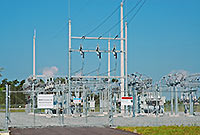 The electrical energy consumed in the industrial, tertiary and residential sectors comes from a technical chain comprising:
The electrical energy consumed in the industrial, tertiary and residential sectors comes from a technical chain comprising:
• Thermal, hydroelectric, nuclear, solar or wind power plants.
• A system for transmitting and distributing this energy via high-voltage and then low-voltage networks.
• An electrical installation in a building.
The main challenge for this technical chain is to ensure a safe, reliable supply of electrical energy, i.e. in compliance with the standards. To ensure that this quality of service is achieved, the actors in the sector perform a large number of measurements when commissioning or carrying out preventive and corrective maintenance. Chauvin Arnoux has a broad offering of measuring instruments specially designed for these operations.
Electrical safety
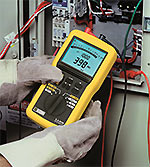 Electrical safety from the distribution network through to the installation in the building is a major issue in terms of protecting people and property.
Electrical safety from the distribution network through to the installation in the building is a major issue in terms of protecting people and property.
This field, closely controlled by standards, recommends or requires checks on essential characteristics of the earthing circuit, insulation resistance, continuity of the conductors and the protective systems.
Tests
Earth and resistivity tests
Earth testers can be used to measure the resistance of an installations earthing, or in other words, its ability to drain a fault current without dangerously increasing the resulting voltage.
Depending on the installation's topology, the measurement may be performed using the classic measurement method with stakes or a selective method, particularly when the environment does not allow the use of stakes. Lastly, when the earthing is provided by a network of multiple earths in parallel, earth clamps can be used to determine the characteristics of the earth network.
Download the Earth/Ground Measurement Guide
The main reason for measuring the electrical insulation of a cable or other item is to prevent problems due to ageing of the materials. These measurements considerably reduce the hazards for equipment (short-circuit and fire) and people (risk of electric shock).
According to the characteristics of the device to be tested, the operator will determine the test voltage to be applied. Chauvin Arnoux insulation testers capable of performing tests up to 1,000 V, 5,000 V and 10 kV – 15 kV are ideal for this task.
Download the Insulation Measurement Guide
Specific tests on transmission and distribution equipment
In addition, Chauvin Arnoux offers instruments capable of performing specific tests for electrical energy transmission and distribution equipment, such as earth testers for networks of pylons, micro-ohmmeters and ratiometers.
Installation tests
To meet the electrical installation testing and maintenance requirements, Chauvin Arnoux proposes bi-function or multi-function installation testers capable of performing all the tests stipulated in the national and international standards (IEC 60364-6, NFC 15100, VDE100, etc.) with a single instrument.
Discover our NFC 15-100 training modules
Thermal tests
As abnormal heating of an electrical device is indicative of potential problems in an electrical installation, a thermographic camera can be used to check, remotely and safely:
- the connections of the cables
- the absence of any heating at the terminals, etc.
The thermal image obtained with the camera shows the different temperature zones, giving a quick, simple overview of the temperature differences. Once the anomaly has been located, repair operations are quicker and the risks are limited.
Thermogram allowing users to check whether the current is evenly distributed at the different terminals.
Electrical power quality
 The quality of the electrical power distributed is a crucial technical feature for ensuring optimum operation of an electrical installation.
The quality of the electrical power distributed is a crucial technical feature for ensuring optimum operation of an electrical installation.
It is measured by determining whether there are disturbances and abnormal events on the voltages, currents and frequencies.
The source of these electrical anomalies may be the usage segment (distribution system or electrical loads on the consumer's side) or the supply segment.
A deterioration of the electrical power quality may cause production losses or shutdowns and higher energy bills linked to the consumption profile.
Chauvin Arnoux's Qualistar+® network and power analysers measure all the voltage and current parameters for electrical power quality diagnostics. The functions of these instruments can be used to acquire and record simultaneously all the parameters concerning transients, alarms and waveforms which can then be analysed with the DataView® software.
This makes it simple to check the values against the standard templates.
List of parameters to monitor
A list of parameters to monitor, uniform terminology for the definitions and help with interpretation of the data have been defined.
Today, the IEC 61000-4-30 standard defines the measurement methods for the parameters needed to qualify the electrical voltage distributed. It includes the definitions of voltage, variations, etc., and other disturbance criteria. It refers mainly to two other standards:
- IEC 61000-4-7 for the parameter measurements linked to distortions of the waveform (harmonics, waveform, etc.)
- IEC 61000-4-15 for Flicker. Flicker Case Study
Energy quality depends on at least twelve key parameters of the electricity supply, including the frequency and the voltage variations referred to above. However, the most critical factor is the distortion of the waveform or the harmonic content. Harmonic voltages may cause malfunctions in sensitive equipment: RCD detection circuits, UPS switches, overheating of conductors.
Harmonics Case Study
The solutions proposed by Chauvin Arnoux monitor compliance with the templates as defined in Europe by the EN 50160 standard or in North America by the CBEMA curve. EN50160 defines the acceptable limits for variations and the number of events tolerated.
The level of the load on a transformer should also be monitored when there are harmonics present. The K Factor (K Factor Case Study) defines the derating of this electrical source.
All these disturbances can be identified very easily with power and energy analysers.
General low-voltage electrical measurements
In the field, it is more efficient to perform simple, on-off tests or measurements allowing rapid diagnosis.
For this, professionals use a multimeter because of its universal capabilities and measurement ranges, or a multimeter clamp, which allows them to determine the current values in total safety, without contact or mechanical operations on the installation or the conductor.
It is crucial to select these two types of instruments carefully in order to achieve a pertinent diagnosis.
Taking advantage of its long experience, Chauvin Arnoux commercializes a wide range of products offering acknowledged functions, safety and rugged design.
Multimeter Selection Guide
Multimeter Clamp Selection Guide
See also the DigiFlex solution
Functions of Chauvin Arnoux Metrix multimeters
The functions expected from a multimeter and a multimeter clamp go well beyond conventional U-I-R measurements… The products proposed under the Chauvin Arnoux® and Metrix® brands include a set of additional functions designed to improve diagnostics:
• TRMS acquisition
• Low-impedance voltage measurement with low-pass filter.
• Acquisition of the Min-Max and Peak values
• TrueInRush current measurement
• Measurements of deviations in relation to a reference, in absolute and relative terms
• Measurement of Total Harmonic Distortion (THD)
User safety is another aspect which must not be neglected. Compliance with the standards (IEC 61010, etc.) is necessary but insufficient if the requirements are not matched to the operating conditions. So if you choose CAT IV 600 V or 1,000 V instruments, you can work on all Low-Voltage applications. As all the elements in the measurement line contribute to safety, this requirement is also applicable to the measurement accessories.
Lastly, the quality of the instrument's design and manufacture is also an important parameter when choosing products. The mechanical and electrical specifications which ensure safety must be preserved over time. In conditions involving pollution (dust, humidity, etc.), a high protection rating (> IP54) ensures that the instrument remains leakproof.
VATs(*): a standard in electrical safety
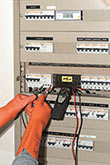 Every professional knows that electricity is never entirely risk-free. This is why they should try to work as much as possible with the power off.
Every professional knows that electricity is never entirely risk-free. This is why they should try to work as much as possible with the power off.
While most professionals already follow this good practice, some countries and customers impose it as an obligation.
Legislation concerning operations on electrical installations
In France, for example:
Decree no. 2010-1118 of 22nd September 2010 concerning operations on electrical installations or in the vicinity
Section 2
General obligations of the employer
§ "Art.R. 4544-4.-The employer defines and implements preventive measures in order to eliminate or, if this is not feasible, to reduce as far as possible the hazards of electrical origin during operations on electrical installations or in the vicinity. For this purpose, the employer ensures that:
"1° The works are carried out with the power off, unless the risk assessment shows that the operating conditions make it dangerous to switch the power off or unless it is technically impossible;
Section 3
Specific stipulations
§ "Art.R. 4544-5.- The works with the power off are carried out in the following conditions:
"1° The part of the installation on which they are performed must first be identified and separated so that, throughout the duration of the works, no voltage may persist, appear or reappear in this part of the installation;
"2° It must only be possible to re-establish the voltage in the part of the installation concerned after removing the separation and only if re-establishment of the voltage does not cause any risks.
At European level,
Part 1 of the EN 50110 standard contains the minimum specifications applicable for all 115 member countries of CENELEC, as well as informative appendices concerning work safety on, with or near electrical installations.
Working procedures / Work with power off
A check on the absence of any operating voltage must always be carried out before starting work. If voltage absence testers or voltage detection systems are used, they must comply with the EN 61243 European standards.
Day-to-day and professional use
Chauvin Arnoux's Voltage Absence Testers (VATs) are important instruments for electricians' safety which are simple and effective because they accompany electricity professionals in the everyday work. Compliant with Edition 2 of the IEC 61243-3 European standard, they include a redundant voltage detection system and comprehensive self-testing is necessary to ensure that they operate correctly. Their CAT IV 600 V rating allows work on all categories of LV installations and their high ingress protection (IP65) means they can be used both indoors and outdoors.
Economical and praised by many professionals, the test-probe accessories and cables are removable and replaceable and can be used with accessories which comply with the IP2X standard.
(*) Voltage Absence Tester
Multimetrix
Multimetrix: "Simple measurement at the best price"
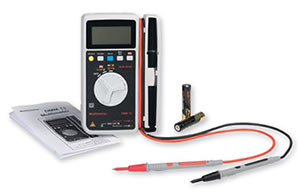
Launched in 2003, Multimetrix® is the entry-level brand which offers sourced products at affordable prices. Its products include multimeters, clamps and testers for electrical safety and environmental measurement which all benefit from the Chauvin Arnoux Group's quality control before commercialization.
Discover our products
Metrix
Originally one of Chauvin Arnoux's competitors, Metrix joined the Group in 1997 and became the brand specializing in industrial, laboratory and educational instrumentation. The brand develops the instruments designed on the historical site at Annecy-le-Vieux, which now houses one of the Group's research centres.
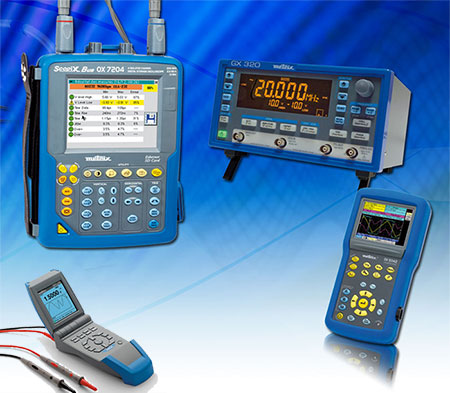
Digital multimeters, oscilloscopes and function generators are designed for the Metrix® brand which is acknowledged for its innovations in terms of design, ergonomics and technology. As the inventor of the key switch (MTX Mobile®), the smallest oscilloscope with isolated channels on the market (Handscope®) and the "flip" multimeter (MTX Mobile®), the brand's instruments regularly win prizes such as the Etoile du Design or the Electron d'Or for their innovative features.
www.metrix.com
Metrix
Originally one of Chauvin Arnoux's competitors, Metrix joined the Group in 1997 and became the brand specializing in industrial, laboratory and educational instrumentation. The brand develops the instruments designed on the historical site at Annecy-le-Vieux, which now houses one of the Group's research centres.

Digital multimeters, oscilloscopes and function generators are designed for the Metrix® brand which is acknowledged for its innovations in terms of design, ergonomics and technology. As the inventor of the key switch (MTX Mobile®), the smallest oscilloscope with isolated channels on the market (Handscope®) and the "flip" multimeter (MTX Mobile®), the brand's instruments regularly win prizes such as the Etoile du Design or the Electron d'Or for their innovative features.
www.metrix.com
Chauvin Arnoux
Chauvin Arnoux®, the Group's eponymous core brand, offers a very broad range of portable measuring instruments for industry, the tertiary sector, housing, government departments, etc.
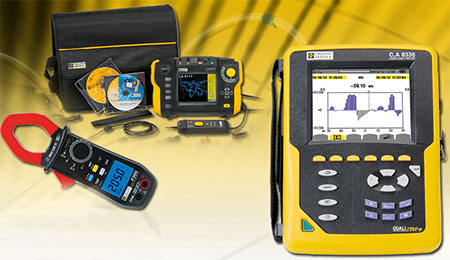
The wide variety of our instruments enables us to meet the requirements of the standards and customers' expectations in the following fields:
- universal testing: testers, VATs, multimeters, clamps, etc.
- electrical testing and safety: installation testers, insulation testers, leakage current clamps, earth/ground testers, micro-ohmmeters, rotation testers, etc.
- network quality: power and harmonics clamps, network analysers,
- physical quantities: calibrators, thermometers, sensors, manometers, luxmeters, sound level meters, tachometers, etc.,
- laboratory instrumentation: training case, analogue testers, The brand benefits from the Group's R&D and integrated production structures which have led to the development of flagship products such as the Qualistar® analyser, the PEL logger and the Digiflex® sensors, which have both recently been awarded prizes by the profession (Electron d'Or and Electron d'Argent in the Electrical Instrumentation category).
Integrated production
Design and production are part of Chauvin Arnoux's fundamentals. Today, the Chauvin Arnoux Group is one of the rare industrial companies in the market to have kept its own production facilities, guaranteeing total control of the production line and the product quality control phases.
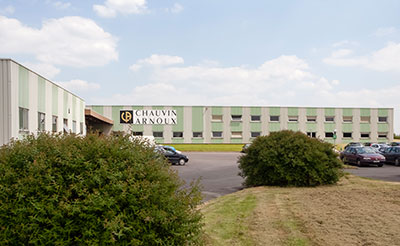
In France, there are three production sites located in Normandy (Vire, Villedieu-les-Poêles and Pont-L’Evèque) which handle manufacturing of the measuring instruments for the Chauvin Arnoux®, Metrix® and Enerdis® brands, from production of the mechanical parts through to assembly and shipment, including construction and wiring of the printed circuits. Another site in Meyzieu, in the suburb of Lyon, designs tailored Pyrocontrole®-brand temperature sensors for the whole world.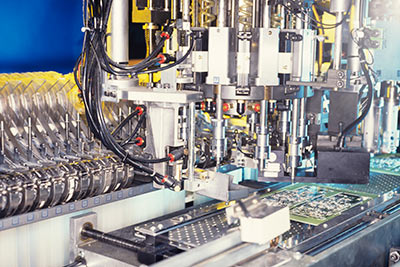
Three other factories spread across the world (Italy, China, USA) complete the Group's set of production facilities.
There are around thirty different professions working to launch the twenty or so new products designed by Chauvin Arnoux every year. Tooling, sheet-metal cutting, machining, winding, printed circuit boards, plastic injection, painting/pad printing, assembly and printing are involved in the different facets of a product's life cycle. In this context, nearly 800 staff are employed for their expertise in these different phases of the manufacturing processes.
All the Group's sites are certified ISO 14001 by the international organization Intertek.








